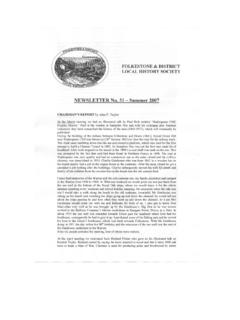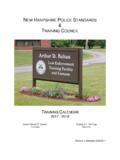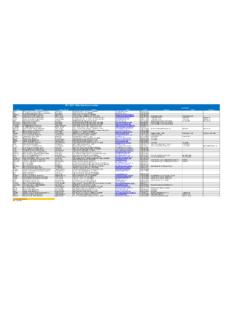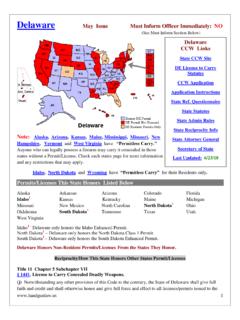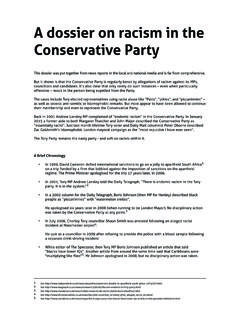Transcription of FOLKESTONE & DISTRICT LOCAL HISTORY SICIETY …
1 FOLKESTONE & DISTRICT LOCAL HISTORY SICIETY NEWSLETTER No. 59- Summer 2014 CHAIRMAN S REPORT by Alan F Taylor At the March meeting we welcomed guest speaker and author Bob Preedy who gave us his presentation entitled Sandgate through the Ages. Bob showed some Aerial views starting with the West Leas which was originally called Sandgate Plain where cricket was played. The famous cricketer Grace actually played there. He talked about Cliff House, Palm Beach and Conamur School on the Riviera. As he continued through Sandgate he was picking out buildings which are not there any more and what had taken their place. Coming back from Seabrook, Bob told us about: the Lifeboat Station which was called the Goose Cathedral, later becoming the Life-Boat Caf before being demolished in 1956 and replaced with a petrol station; the Military Hospital on Hospital Hill; the Sandgate railway branch line from Sandling which opened on Friday 9th October 1874 and closed on 31st March 1931 and Encombe House which was destroyed in 1978 by a mysterious fire.
2 Encombe s entrance gates however are still there today. Two notable events were the loss of the 2,033-ton sailing ship Benvenue in the great storm on 18th February 1899 and the landslip which started on Saturday evening, 4th March 1893. Also mentioned was the Sea Point caf which opened as a tea lounge in 1930, at which time the proprietress was Mrs. M. Gresham-Smith. The building was undermined by storms on 13th January 1949 causing part of the building to collapse; it was subsequently demolished. Bob spoke about: Sir John Moore who was the commandant at Shorncliffe Camp between 1803 and 1805 and his memorial which was unveiled on Friday 19th November 1909; the Coastguard Cottages; Devonshire Terrace which was also damaged by the storms in 1949 and again in 1968; the Alfred Bevan Memorial Convalescent Home, 113 Sandgate High Street, formerly the Beach Rock Convalescent Home founded by the London Samaritan Society and opened on 25th June 1892 (Homevale House now occupies the site); The Alhambra Palace of Varieties which became the Rex cinema and later Rayner s Beach Club - this site is now occupied by Tower Court; The Royal Kent hotel; and Caffyns Ltd Motor Engineers, formerly Maltby s Motor Works, which was destroyed by fire on 19th June 1960.
3 Riviera Court now stands on the site. Other buildings Bob spoke about were the Ship Inn, Pear Tree Cottages, the Wesleyan Church, and the Star and Garter Convalescent Home, formerly Enbrook House, which later became the Police Training College and now is the site of the Saga building. Bob also talk about Granville Parade, Sandgate Castle and Sandgate School. Fifty-five people attended the meeting eight of whom were visitors. At the April meeting we welcomed Christine Waterman who gave us her presentation on The Mason Dieu, dover . Christine said she was the curator at dover museum for twenty years after which she worked in the housing department for dover DISTRICT Council, but is now retired, and she is the Vice-Chairman of St Margaret s Bay HISTORY Society. The original building on the site of the present Mason Dieu was built in 1203.
4 The Royal Charter of the Mason Dieu, forming the earliest Monuments of that ancient hospital, was founded for the relief of pilgrims by Hubert de Burgh, (1160-1243) Earl of Kent. It was run by the Augustinian Monks. From 1544 to 1834 the building was a Victualling Store for the navy. Mason Dieu House was built for Mr Russell but was used as the Navy Victualling Office from the reign of Queen Elizabeth until after the Battle of Waterloo. Subsequently, it was occupied by the commanding Royal Engineer at dover until it was sold as a private residence. In 1881 the building was purchased by the Council to house its museum and is now Council offices. Christine spoke about the Market Square and Court Hall which was built in 1605 and the Gaol built in 1818. Ambrose Poynter the Architect (1834-1881) was commissioned to design a restoration for the Mason Dieu.
5 3,500 was borrowed to do the job, but Ambrose Poynter died before the work started in 1861, so the work was overseen by William Burges, architect. In 1866 at the cost of 7,000 a prison was built on the side of the Mason Dieu plus a new council chamber which is still used today. Then in 1881 the Function Hall, Police Station, Museum and Civic Centre - Connaught Hall were all refurbished under the supervision of William Burges at the cost 17,500. Christine finished by speaking about the Town Hall clock, the Mayor s Parlour with its decorative ceiling and the Astley Organ. Fifty-five people attended the meeting, three of whom were visitors. At the May meeting we welcomed member speaker and author Martin Easdown who presented us with his presentation on The Great Air Raid on FOLKESTONE . Martin started by showing pre-war images of the Leas, Metropole Hotel, Victoria Pier, fishing fleet and Harbour.
6 He went on to talk about what was happening in Europe during 1914 before war was declared. The assassination of Archduke Franz Ferdinand, heir to the Austro-Hungarian throne, on 28 June 1914, set in train a series of diplomatic events that led inexorably to the outbreak of war in Europe at the end of July 1914. After the sinking of four German battle ships on December 16th 1914, the Germans retaliated with a bombardment on Scarborough followed by a salvo on Hartlepool causing the death of 114 civilians plus 18 military personnel. He spoke about the first Zeppelin raids on the night of 19th & 20th January 1915, targeting Norfolk leaving 4 dead and 15 injured; and the raids on Sitingbourne and Faversham on 16th April 1915, Ramsgate on 16th May 1915 and Otterpool Camp, between Lympne and Sellindge, where 15 Canadian soldiers were killed on October 14th 1915.
7 During 1916 the East Kent coast was subject to German naval seaplane raids - towns bombed included: dover , Broadstairs, Ramsgate, Walmer and Margate. Up until this time FOLKESTONE was unscathed, but on 25th May 1917 German Gotha bombers due to raid London aborted due to cloud cover so they attacked Kent. The places bombed included: Luddesdown, Harvel, Linton, Maden, Pluckley, Smarden, Kingsnorth, Shadoxhurst, Mersham, Ruckinge, Bilsington, Lymnpe airfield, Sandling, Hythe, Sandgate. At FOLKESTONE 51 bombs were dropped 31 exploded, 14 didn t explode and 6 fell in the sea. Properties were damaged in: St John s Street; Bouverie Road East including Christ Church School; Osborne Hotel on the corner of Bouverie Road West and Christ Church Road; West Lodge at 21 Manor Road; the Central station; the corner of Foord Road and Radnor Park Road; and Tontine Street at 6 pm, where one bomb killed 61 people.
8 Some of them were in a pototo quew outside Stokes greengrocers and others taking a leisurely stroll along the street. This was the first ever raid on Britain by German Gotha bombers - 78 civilians and 18 military personnel (96 in total) were killed in FOLKESTONE and its neighbourhood. Martin continued by showing us portraits and gravestones in Cheriton Road Cemetary of those who were killed, many of them children. He finished with images of the Military Cemetary at Shorncliffe Camp where school children laid flowers on 13th June (Dominion Day) 1917. The ceremony continues to this day, but is now held on 1st July (Canada Day). Sixty-two people attended the meeting, fourteen of whom were visitors..We would like to welcome new member Mike Cole. Battle of Britain Diary FOLKESTONE 1940 continued September 15th Enemy patrols reported after between Lympne and Dungeness at Main raids crossed coast at various points, including Dungeness.
9 Mixed formation of Dornier Do 17 s and Do 215 s, escorted by Bf. 109 s at heights between 15,000 feet and 26,000 feet the bombers looked like black dots trailing streams of vapour. Five Spitfire squadrons intercepted raids making for London, running battles over East Kent for three-quarters of an hour. One yellow-nosed Bf. 109 was attacked over Maidstone by a Hurricane, managed to glide as far as Hamm s Farm, Bilsington before crashing onto a garage and destroying car inside, and killing two women. A Polish pilot with No. 253 Squadron forced landed with engine failure after combat over Dungeness; another Bf. 109 reported missing. Three more Bf. 109 s brought down at Dymchurch; Lympne and St. Michael s, Tenterden. September 16th Some bombs dropped of Woodchurch at , one house damaged; and another slightly damaged.
10 A German bomber exploded in the air - large crater in a field, killing one civilian who was not found until two days later. Four UXB s reported near Sellindge Farm at Six s dropped at Woolpack Corner, Biddenden at September 17th Bombs dropped by Lydd just before midnight, four on Pigwell Farm, four in sea 300 yards off Lade Coastguard lookout; large dropped mile of Brookland Church at , during heavy night raids on London coming in over Dungeness. Some 20 high explosives, many incendiary bombs, two oil bombs dropped near Alkham, 5 s near Chilton Nursery, one UXB at Chilton Farm, many bombs in fields; minor damage to unoccupied bungalow. Three s 300 yards of Old Cheney Court, New Romney at September 18th More night bombing, at high explosives and oil bomb dropped near Wittersham; two s at Gulfbourne Farm, Appledore at Two UXB s reported at Paraker Wood, near Hythe cemetery at , one of which exploded at Elham reported bombing during the evening, whistling sound followed by loud explosion, large crater discovered 20 feet deep and 20 feet in diameter.
